
You can't read anything until you know the alphabet, so if you want to read Greek, the alphabet is a logical place to start. You can learn the Greek alphabet in an hour or two, and if this is all you ever learn, it is enough to let you look up entries in a Greek dictionary, pronounce Greek words, and feel a little less frightened by those weird looking squiggles.
We learn how to pronounce the letters by reading some verses from the Gospel of John. I have recorded these verses so that you can read along with me and compare your pronunciation to mine. In the following table, the first row shows the capital letters, the second shows the small letters, and the third shows their English equivalents:

Hint:You do not have to learn this table yet - the rest of this section will teach you how to pronounce these letters.
Hint:If you want to see tables with all the stuff we will be learning, look at the Tables and suchsection for this chapter.
In this exercise, you will learn to pronounce the first five verses of John 1. Below, you can see a phrase written in Greek letters, and a transcription for the same phrase just below that. If you click on the Greek phrase, you will hear me read it out loud. Look at the Greek letters and listen to me read; match it up with the transcription to make sure that you are hearing it correctly:
| En | archê | ên | ho | logos |
Read the above phrase several times, until you can look at the letters and pronounce the words correctly. Note that "ê" is pronounced like "ey" in "they".
In the above text, note that in every word that starts with a vowel, the initial vowel has a mark over it that looks like a comma. If the comma is backwards, it is called a "rough breathing", and the vowel is pronounced as though there were an "h" before it. If the comma is not backwards, it is called a "smooth breathing"; a smooth breathing indicates that there is no "h" sound before the vowel. Here are two real words that from the first five verses of John that differ only in the breathing:

Question:Which word in John 1:1a has a rough breathing? How does this affect the pronunciation of that word?
In the above text, accents are used to show which syllable is stressed. There are three accents in Greek, and they are all pronounced exactly the same:

In the transcription shown in the bottom row, the accented syllables are shown in bold type.
Question:Which words in John 1:1a have accents? Read the phrase again carefully, and make sure that you stress the accented syllables.
Now look at the words in the following table. The Greek words are shown on the left, the transcription in the middle, and an English translation is given on the right. Read each Greek word out loud, then read the English translation. Repeat each word pair three times out loud. Pay careful attention to the Greek letters as you read, and make sure you can identify the smooth breathings, the rough breathings, and the accents:
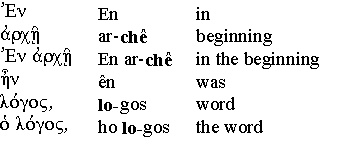
Note:the word "the" does not occur in the Greek, but has to be added when translating to English. English and Greek think differently.
Exercise:Write out the phrase, writing the letters as shown in the section on how to write Greek letters. Please write all the accents and breathing marks. You will notice a little squiggle under the last letter of "arch"; this is called an iota subscript. The iota subscript is not pronounced, but it tells you something important about the grammar...and we won't tell you exactly what for a few more lessons. Just write it, and don't ask any questions, OK?
| kai | ho | logos | ên | pros | ton | theon |
The "ai" sound in "kai" rhymes with "eye". This is a dipthong - a combination of two letters that is pronounced as one sound.
Continue as for the previous verse:
Read each Greek word out loud, then read its translation out loud. Repeat each pair three times:
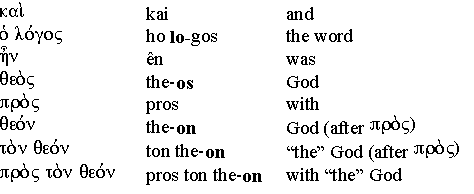
Note:here the Greek says "the" God, but we would translate this "God" in English. The Greek word for "the" acts very differently from the English word "the".
Now write out the phrase, writing the letters as shown in the section on how to write Greek letters.
You have already encountered all of these words in the first two parts of this verse. Listen to the recording and speak along with me, then write out the phrase.
For each verse, do the following:
When you have done this for each verse, you should be able to pronounce the entire set of five verses.

outoVcontains a dipthong - the oucombination is pronounced "who". The "h" sound comes from the rough breathing - without a rough breathing it would be pronounced "ooh". Note that the breathing mark and accent are placed on the secondletter of a dipthong.

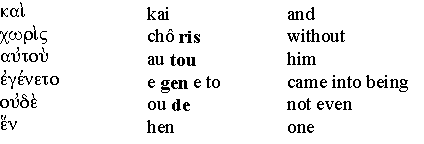
There are two dipthongs here: "au" is pronounced "ow"; "ou" occurs twice in this verse - do you remember how to pronounce it? If not, look at John 1:3a again.
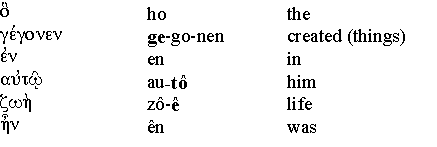
The letter that looks like a "w" is an omega (w), and is pronounced "o", as in "toad". In our transcription, we represent this with "ô".
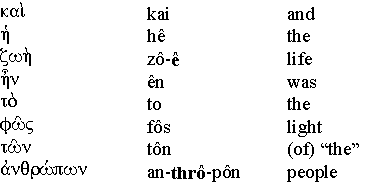
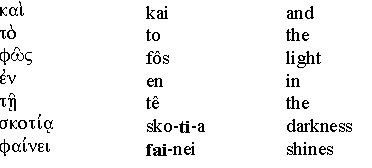

The first five verses of John do not contain the letters m, x, yor the dipthongs eu, oi, or ui. Here is a table with words to help you learn these sounds. Press hereto hear me read these words:
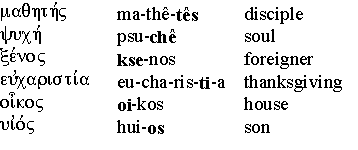
Now try pronouncing the entire passage. If you are unsure about the pronunciation of any word, or if you are unsure about the meaning of individual words, go back to the relevant section of this exercise. If you are unsure of the meaning of a phrase, but understand the individual words, look it up in a Bible translation, preferably a fairly literal one like the King James, RSV, NASB, or NRSV. Do not continue until you are very solid on this.

In this course, each lesson builds on the vocabulary and syntax learned in earlier lessons, so make sure that you remember the things mentioned in this section. First, make sure that you can distinguish these three words:

These are all extremely common words, which you should remember for future lessons. And here are some more common words which you should remember:

Now let's start talking about that pesky word "the". There are three ways to say "the", depending on whether you are referring to something that is masculine, feminine, or neuter:
![]()
In Greek, every noun is either masculine, feminine, or neuter. You should learn these examples, which appeared in today's lesson:
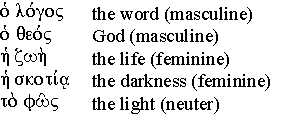
The gender of a noun: The gender of a noun has nothing to do with whether it is a boy or a girl. In English, we refer to a dog as "he" if it is a boy, "she" if it is a girl, or "it" if we do not know its gender (or if it has just returned from an unpleasant visit to the veterinarian). In New Testament Greek, there is no direct link between the gender of a noun and male or female traits; e.g., a mother-in-law is neuter, both boys and girls are neuter, words are masculine, parables are feminine, and both male and female horses are masculine.
The meaning of the article:The article is like a finger pointing; it says, "this one", and should generally be translated "the". For instance, in our passage, o logoVmeans "the word".
What does the lack of an article mean?Many beginning textbooks suggest that a noun without an article should be translated with "a", e.g. that logoVshould be translated "a word" if the article does not appear. This is often a useful way to translate, and a reasonable rule of thumb, but it is not always appropriate. Whereas the article has a clear meaning, the lack of an article has no clear meaning. For instance, in John 1:1, archclearly refers to "the beginning", not to "a beginning":
![]()
John 1:1c contains another interesting example of a noun without an article:
![]()
Grammatically, there are three possible ways to interpret qeoVin this verse:
"And the word was God" - the translation found in most traditional Bibles.
"And the word was a god"
"And the word was divine"
Since Greek grammar permits each of these meanings, you have to look at the context and the belief system of the writer in order to understand which meaning is most likely. Given John's understandings of Jesus and of God, it is very unlikely that he would have said that Jesus was "a god".
Where do you go from here?